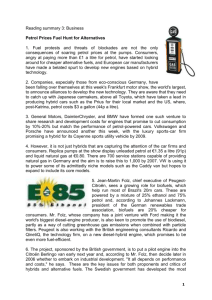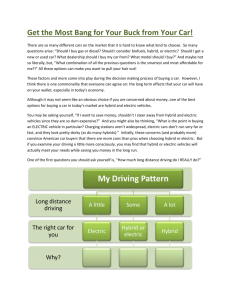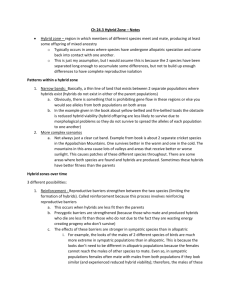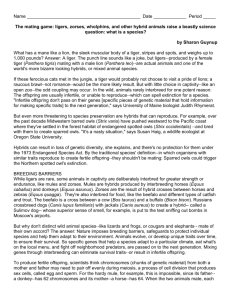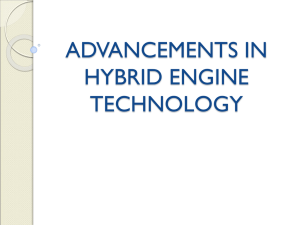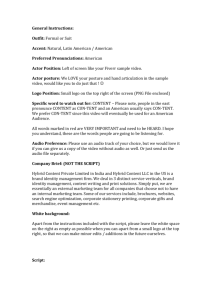LN Text F&V WS-05
advertisement
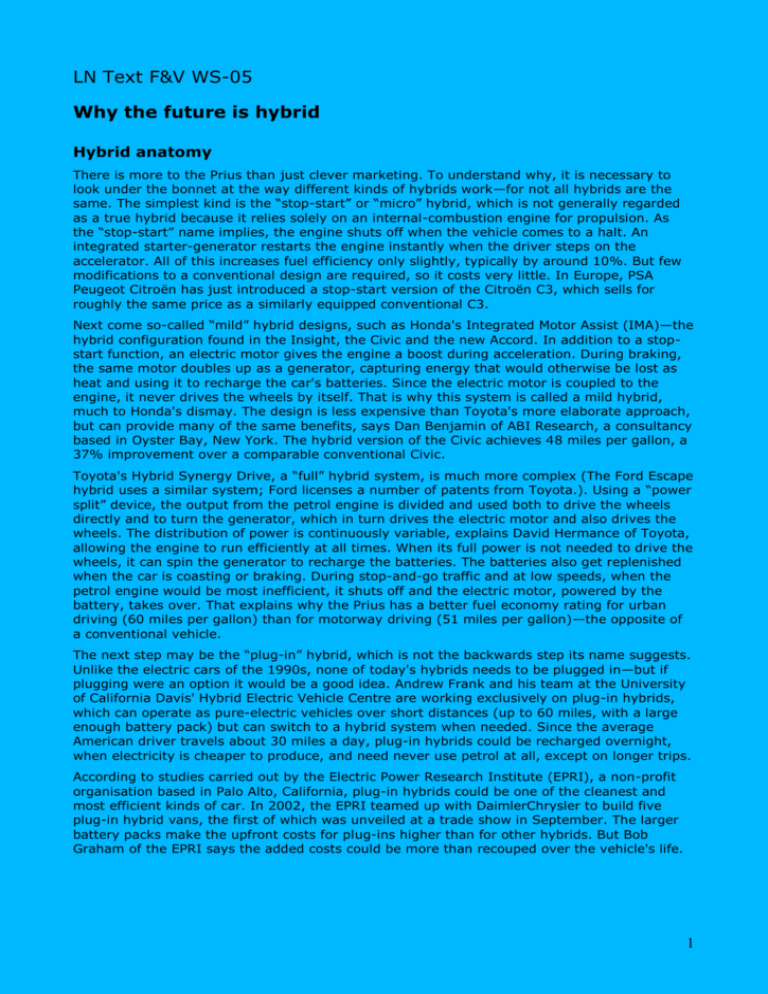
LN Text F&V WS-05 Why the future is hybrid Hybrid anatomy There is more to the Prius than just clever marketing. To understand why, it is necessary to look under the bonnet at the way different kinds of hybrids work—for not all hybrids are the same. The simplest kind is the “stop-start” or “micro” hybrid, which is not generally regarded as a true hybrid because it relies solely on an internal-combustion engine for propulsion. As the “stop-start” name implies, the engine shuts off when the vehicle comes to a halt. An integrated starter-generator restarts the engine instantly when the driver steps on the accelerator. All of this increases fuel efficiency only slightly, typically by around 10%. But few modifications to a conventional design are required, so it costs very little. In Europe, PSA Peugeot Citroën has just introduced a stop-start version of the Citroën C3, which sells for roughly the same price as a similarly equipped conventional C3. Next come so-called “mild” hybrid designs, such as Honda's Integrated Motor Assist (IMA)—the hybrid configuration found in the Insight, the Civic and the new Accord. In addition to a stopstart function, an electric motor gives the engine a boost during acceleration. During braking, the same motor doubles up as a generator, capturing energy that would otherwise be lost as heat and using it to recharge the car's batteries. Since the electric motor is coupled to the engine, it never drives the wheels by itself. That is why this system is called a mild hybrid, much to Honda's dismay. The design is less expensive than Toyota's more elaborate approach, but can provide many of the same benefits, says Dan Benjamin of ABI Research, a consultancy based in Oyster Bay, New York. The hybrid version of the Civic achieves 48 miles per gallon, a 37% improvement over a comparable conventional Civic. Toyota's Hybrid Synergy Drive, a “full” hybrid system, is much more complex (The Ford Escape hybrid uses a similar system; Ford licenses a number of patents from Toyota.). Using a “power split” device, the output from the petrol engine is divided and used both to drive the wheels directly and to turn the generator, which in turn drives the electric motor and also drives the wheels. The distribution of power is continuously variable, explains David Hermance of Toyota, allowing the engine to run efficiently at all times. When its full power is not needed to drive the wheels, it can spin the generator to recharge the batteries. The batteries also get replenished when the car is coasting or braking. During stop-and-go traffic and at low speeds, when the petrol engine would be most inefficient, it shuts off and the electric motor, powered by the battery, takes over. That explains why the Prius has a better fuel economy rating for urban driving (60 miles per gallon) than for motorway driving (51 miles per gallon)—the opposite of a conventional vehicle. The next step may be the “plug-in” hybrid, which is not the backwards step its name suggests. Unlike the electric cars of the 1990s, none of today's hybrids needs to be plugged in—but if plugging were an option it would be a good idea. Andrew Frank and his team at the University of California Davis' Hybrid Electric Vehicle Centre are working exclusively on plug-in hybrids, which can operate as pure-electric vehicles over short distances (up to 60 miles, with a large enough battery pack) but can switch to a hybrid system when needed. Since the average American driver travels about 30 miles a day, plug-in hybrids could be recharged overnight, when electricity is cheaper to produce, and need never use petrol at all, except on longer trips. According to studies carried out by the Electric Power Research Institute (EPRI), a non-profit organisation based in Palo Alto, California, plug-in hybrids could be one of the cleanest and most efficient kinds of car. In 2002, the EPRI teamed up with DaimlerChrysler to build five plug-in hybrid vans, the first of which was unveiled at a trade show in September. The larger battery packs make the upfront costs for plug-ins higher than for other hybrids. But Bob Graham of the EPRI says the added costs could be more than recouped over the vehicle's life. 1 Not everyone is bothered by high fuel consumption, however, as the current enthusiasm for enormous SUVs demonstrates. So hybrids seem likely to remain a niche: ABI Research predicts that by 2010, less than 5% of all cars sold in America will be hybrids, assuming current petrol prices persist. But if Alan Lloyd has his way, hybrids and other low-emission vehicles will become far more commonplace. Dr Lloyd is head of the California Air Resources Board (CARB), a state agency that enforces arguably the most stringent air quality rules in the world. California recently passed landmark legislation to curb the emissions of greenhouse gases by 30% beginning in 2009. Since carbon-dioxide emissions are directly linked to a car's fuel consumption, critics charge that the new rules are in effect a way to legislate fuel economy, which is supposed to be regulated by the federal government, not the states. As a result, carmakers are expected to challenge the new rules in court. Sales of hybrids in Europe are a fraction of those in America. Instead, diesel cars have become Europe's answer to reduce fuel consumption, curb greenhouse emissions and save money at the pump. Because diesel fuel contains more energy per unit, the fuel economy of diesel cars is roughly 30% better than that of petrol-powered cars. Moreover, diesel cars are not as loud or dirty as they once were, thanks to technologies such as electronically controlled “common rail” fuel-injection systems. Diesels now make up about 45% of all newly registered cars in Europe. Even so, they still lag behind petrol engines in terms of cleanliness. In the process of combustion, diesels create a lot of pollution, including nitrogen oxides which cause smog, and particulate matter that can cause respiratory problems. That said, some carmakers have begun to equip their cars with particulate filters, notably PSA Peugeot Citroën. Together with two British firms, Ricardo and QinetiQ, the company is building a diesel-hybrid based on the family-sized Citroën Berlingo. The aim is to achieve a combined fuel economy of 70 miles per gallon with carbon-dioxide emissions of only 90 grams per kilometre. (In comparison, the Prius delivers 55 miles per gallon with carbon-dioxide emissions of 104 grams per kilometre.) While it is uncertain whether the car will be mass produced, it is clear that a diesel-electric hybrid would make for an extremely frugal vehicle. A study by the Laboratory for Energy and the Environment at the Massachusetts Institute of Technology, which looked at energy use over the course of a vehicle's life, predicts that by 2020, diesel hybrids could achieve the same energy-efficiency and greenhouse-gas emissions as fuel-cell cars powered by hydrogen made from natural gas. The difference is that diesel-hybrid technology is available today. So why are diesel hybrids taking so long to appear on the roads? Hybrid diesels impose a double price premium, explains Lindsay Brooke, an analyst at CSM Worldwide. Combining a diesel engine, (which costs around $2,000 more than a petrol engine) with a hybrid powertrain (which adds another $3,000 or so) would make for an expensive proposition. Systems to treat the exhaust would impose further costs. The prospects for diesels and diesel hybrids are particularly dim in America, where regulations in California (and, from 2007, nationwide) require diesels to be as clean as petrol-driven cars. Some progress has been made: particulate filters can now eliminate more than 90% of diesel soot. But traps for nitrogen oxides remain a challenge. The car of the future, today Hydrogen fuel-cell vehicles promise to be the cleanest mode of transportation, eliminating harmful tailpipe emissions altogether. But despite much publicity, and the fact that most carmakers are working on the technology, fuel-cell cars will not appear in significant quantities any time soon. America's National Academy of Sciences, which advises the government on new technologies, recently estimated that the transition to a “hydrogen economy” will probably take decades, since many challenges remain—in particular, how to produce, store and distribute hydrogen in sufficient quantities. Hybrid cars, however, offer many of the benefits of fuel-cell vehicles, with the huge advantage that they are available now. Moreover, as the success of the Prius shows, people will actually buy them. The beauty of petrol-electric hybrids is that they do not require any changes in driver behaviour or the fuel-delivery infrastructure. 2 Rather than being mere stepping-stones on the way to the hydrogen cars of the future, petrolelectric hybrids are likely to be around for years, if not decades, to come. When and if fuel-cell cars become available down the road, they may not replace hybrids, but instead are likely to be descended from them, since they require many of the same components, from control systems to motors. As Joseph Romm, director of the Centre for Energy & Climate Solutions, a non-profit organisation based in Arlington, Virginia, puts it, “hybrids are almost certainly the platform from which all future clean vehicles will evolve.” 3
